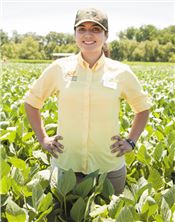Multiple Modes Of Action Best For Resistance

Alice Cochran, graduate student with the University of Tennessee in the Department of Plant Entomology and Plant Pathology under Dr. Heather Kelly discusses fungicide resistant frogeye leaf spot and ways to try to control it.
Photo by John LaRose, Jr.
BETTY VALLE GEGG-NAEGER
MidAmerica Farmer Grower
MILAN, TENN.
Farmers learned more about fungicide resistant frogeye leaf spot when Alice Cochran, graduate student with the University of Tennessee in the Department of Plant Entomology and Plant Pathology under Dr. Heather Kelly.
“Frogeye leaf spot disease is caused by the fungus Cercospora sojina and it causes foliar lesions on soybean that reduce the photosynthetic area on the plant and and results in yield loss,” she explained. “There are different ways to try to control this disease, including planting resistant varieties, crop rotation, foliar fungicide applications and seed treatments. Foliar fungicides are one of the most common disease management strategies for FLS.”
Reliance on foliar fungicides became problematic, starting in 2010, when there began to be reports of QoI fungicide resistant frogeye leaf spot. The QoI fungicides, also known as strobilurin fungicides, which are commonly used for this disease, may no longer be as effective on their own at controlling this disease.
“We’ve started to recommend using fungicides with multiple modes of action to reduce selection pressure for fungicide resistance, because as you continue to apply strobilurin fungicides you kill off the sensitive isolates but the resistant isolates remain in your fields and over time solo strobilurin/QoI fungicide applications won’t be effective at controlling frogeye,” Cochran said. “Using something like a strobilurin plus a triazole (DMI) fungicide combination is likely to reduce selection for resistance and provide better control. We’re also researching the effects of three way combination products, such as a QoI plus a SDHI plus a DMI.”
When growers consider this problem, one of the things they need to focus on is to make sure their fields even warrant having a fungicide application. Sometimes when there is really low disease pressure an application may not be needed, and it would be a waste of time and money. Moderate to high disease pressure is needed to make a fungicide application worth it.
Cochran’s take-home message is to use multiple modes of action if there’s frogeye leaf spot.
“Also, take a look at your varieties and the disease pressure in your field to see if you even need a fungicide,” she said. ∆
BETTY VALLE GEGG-NAEGER: Senior Staff Writer, MidAmerica Farmer Grower